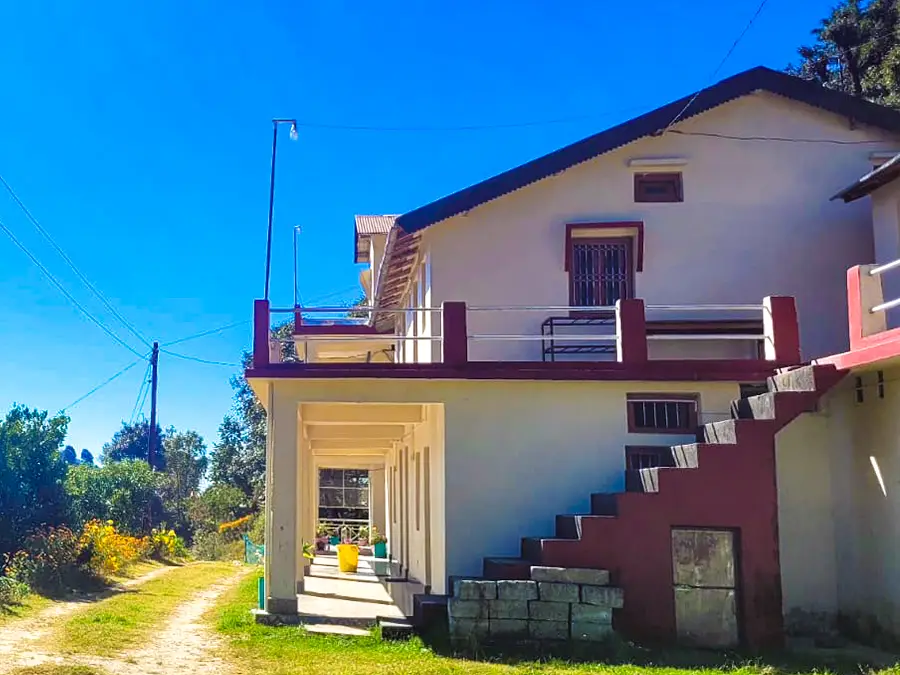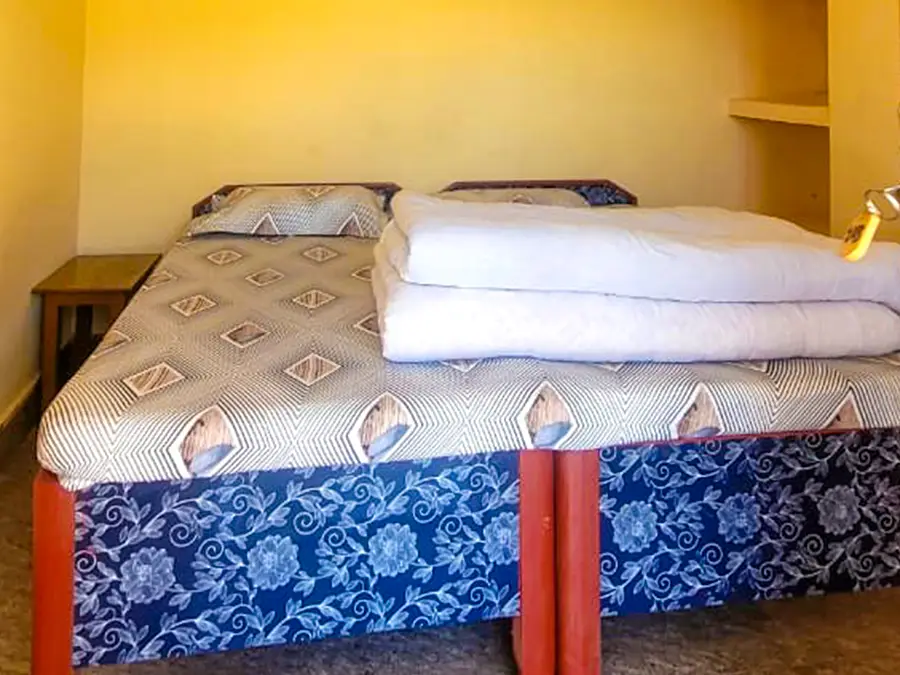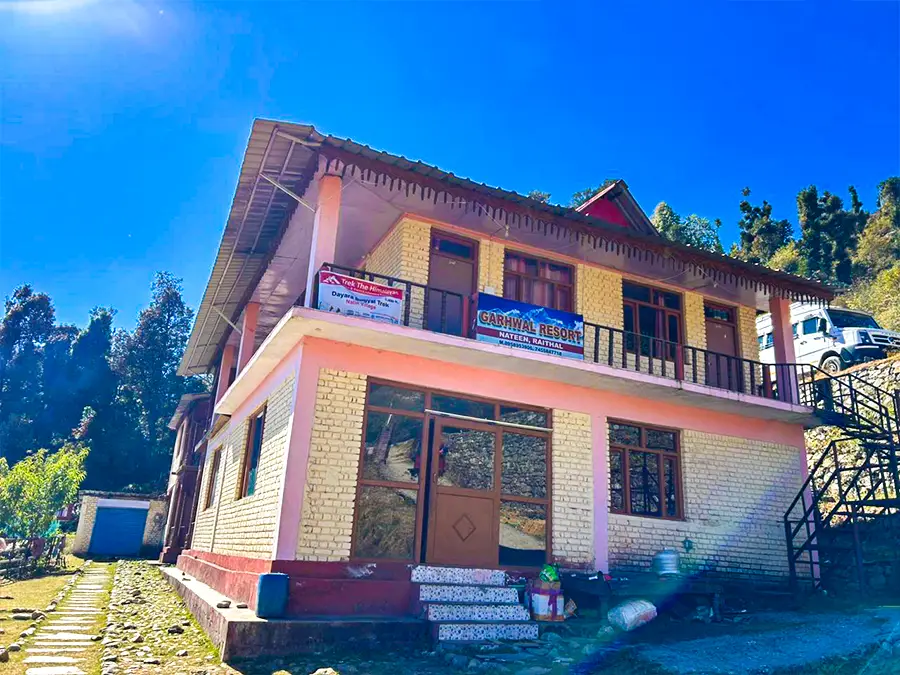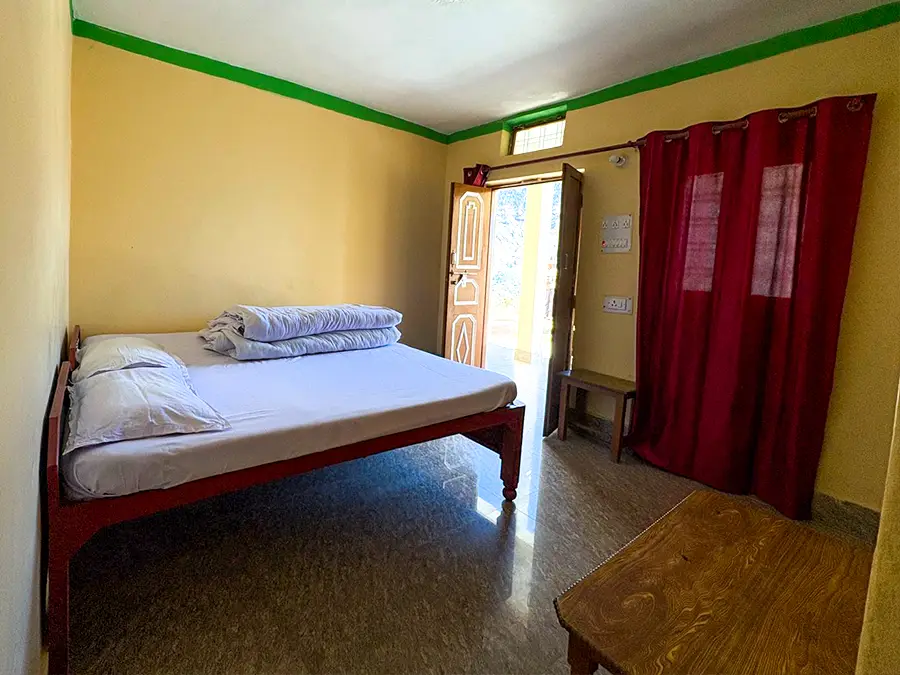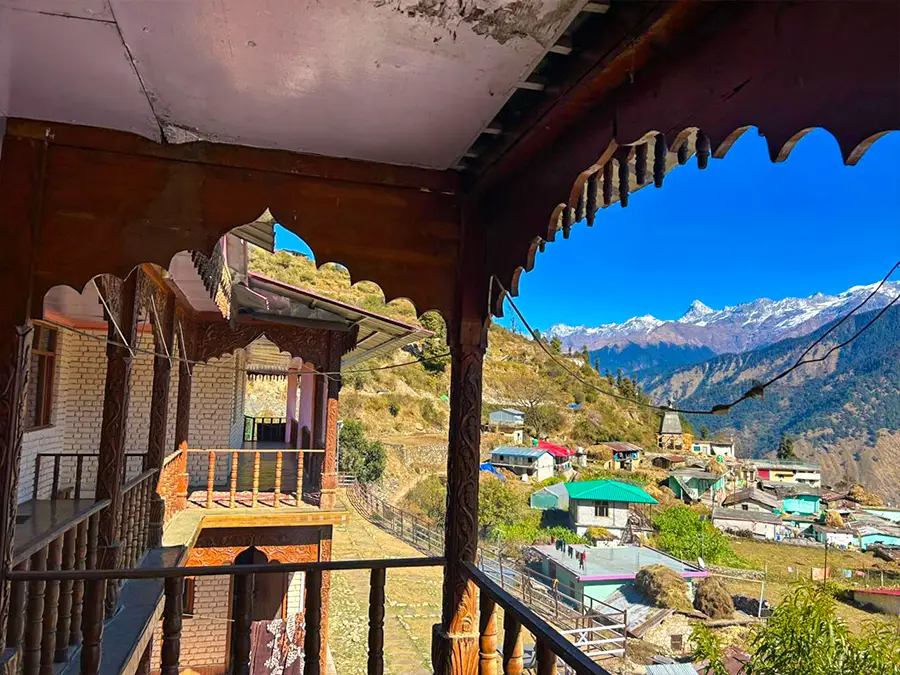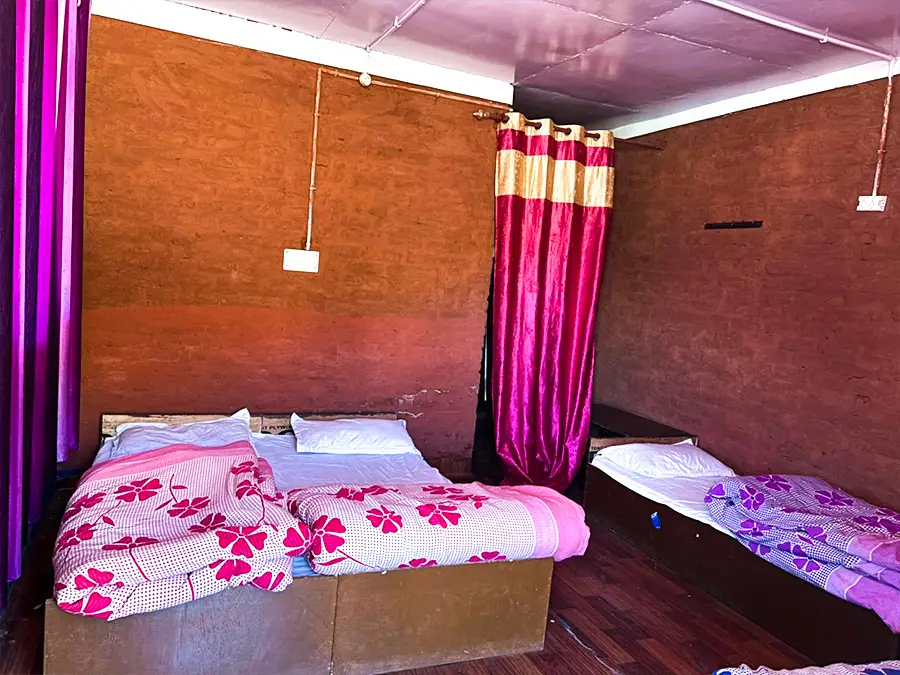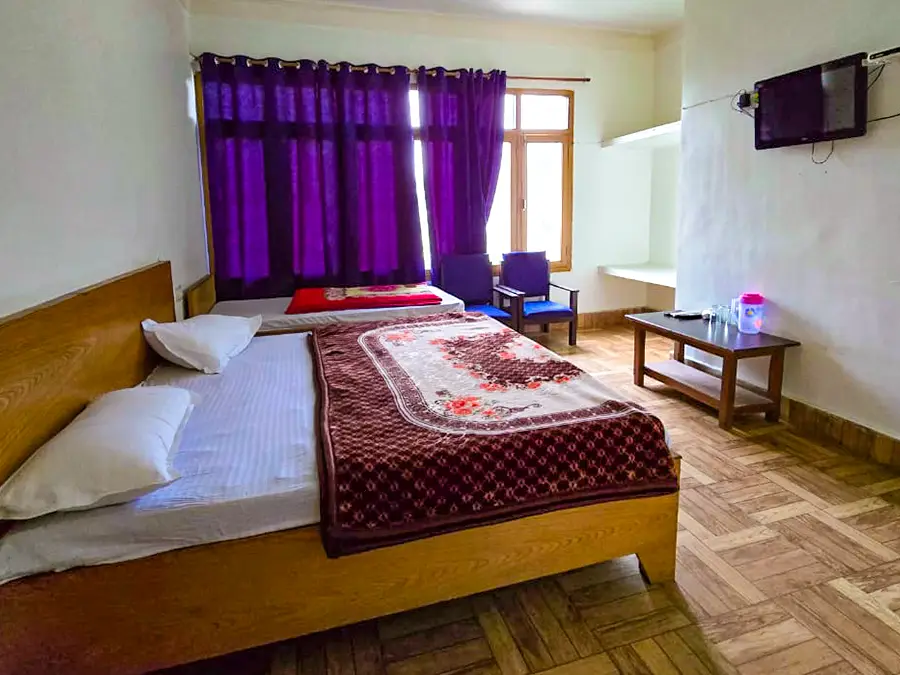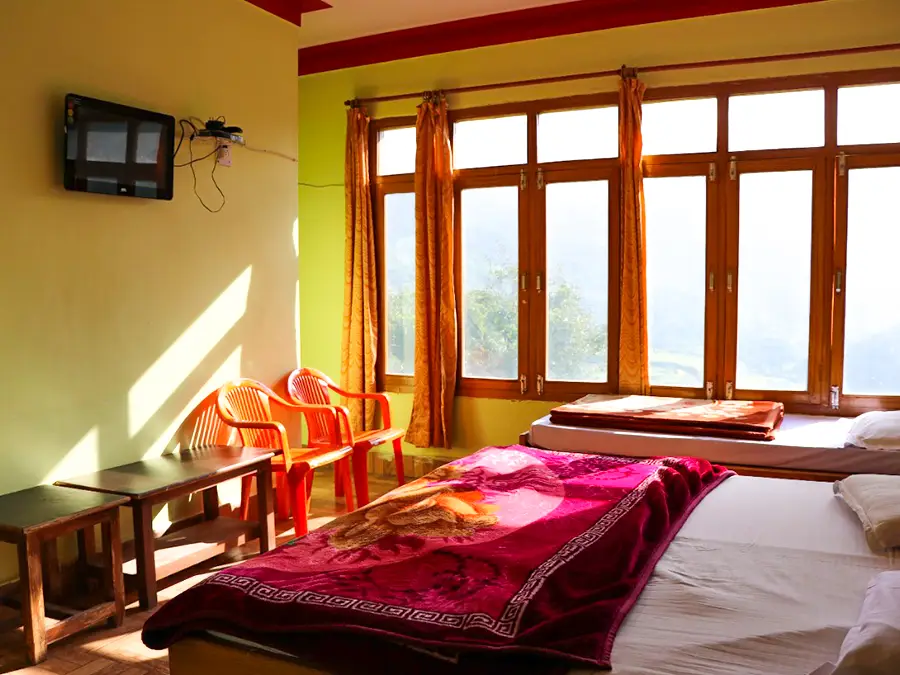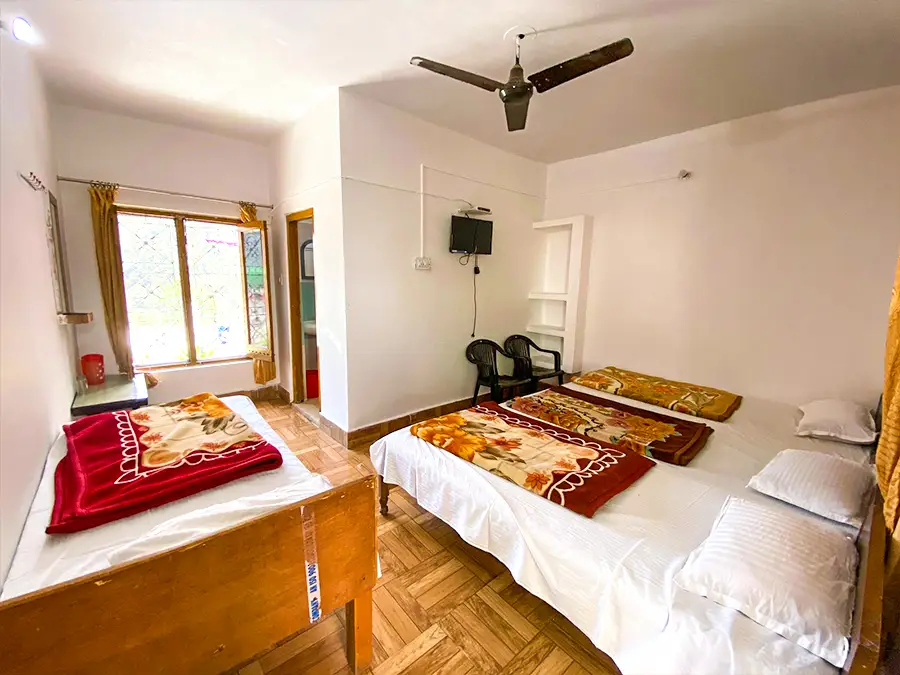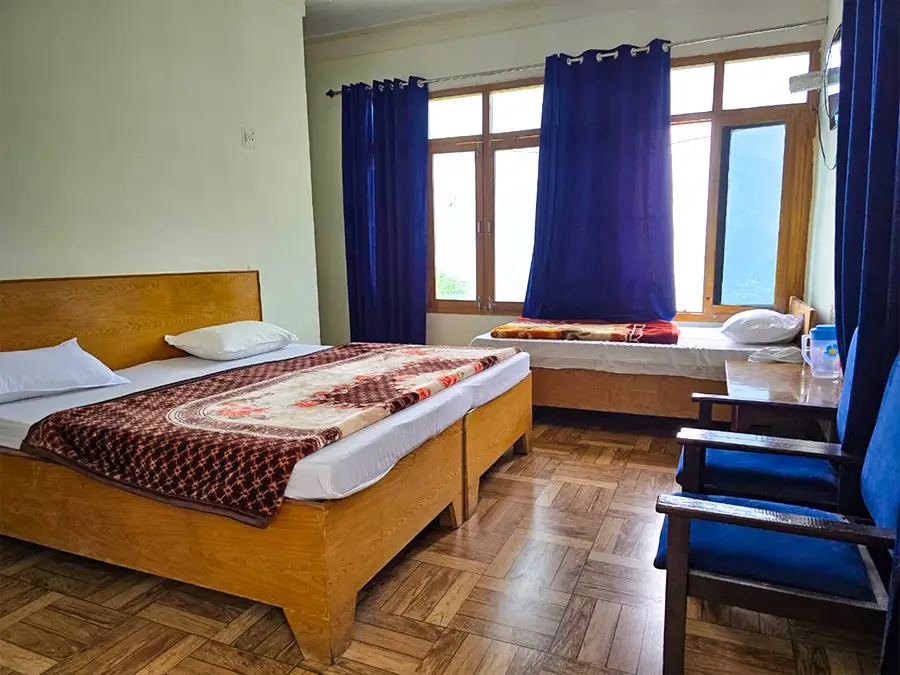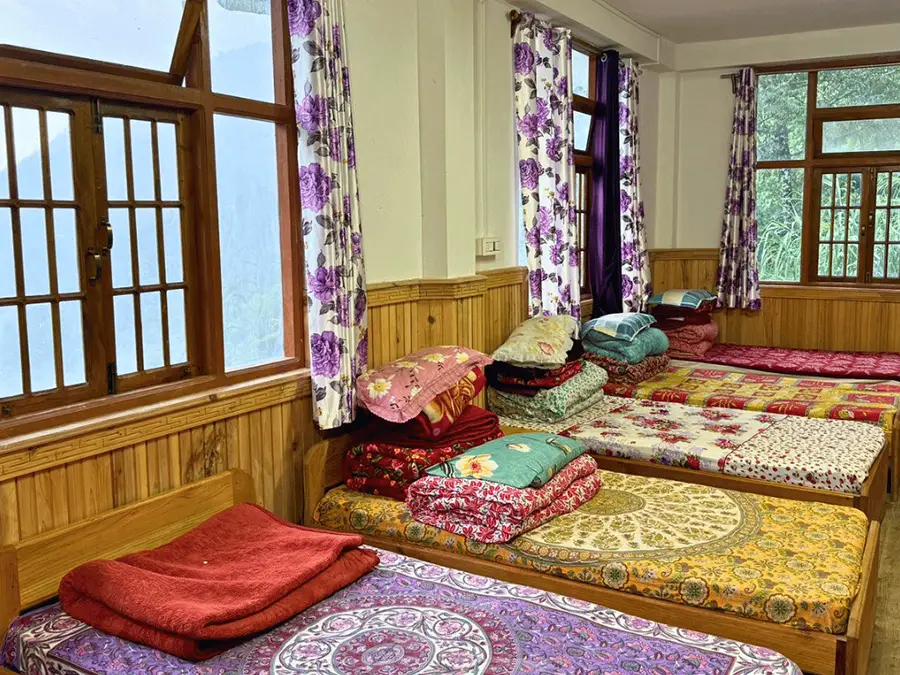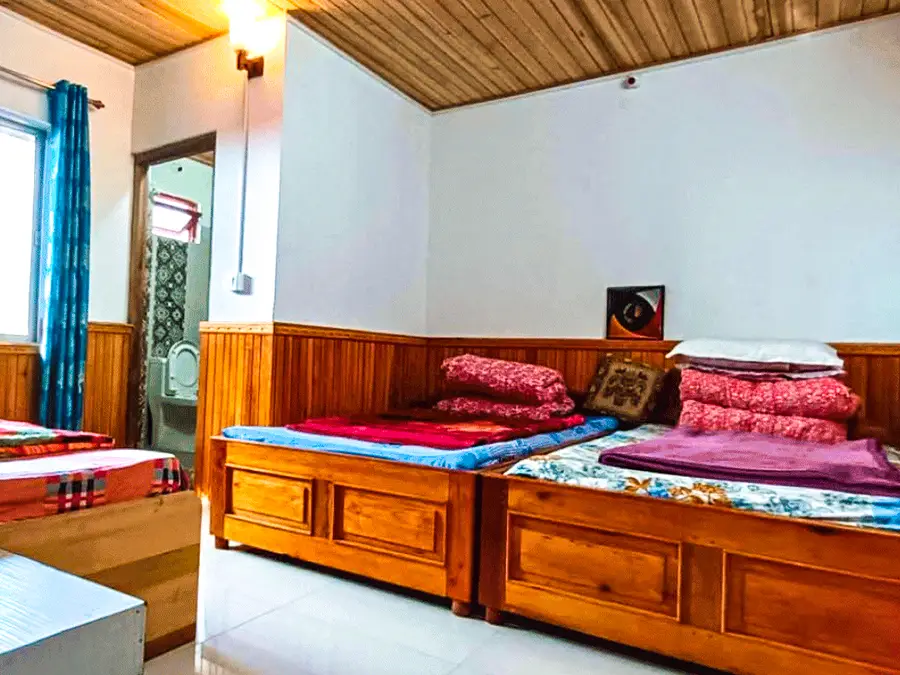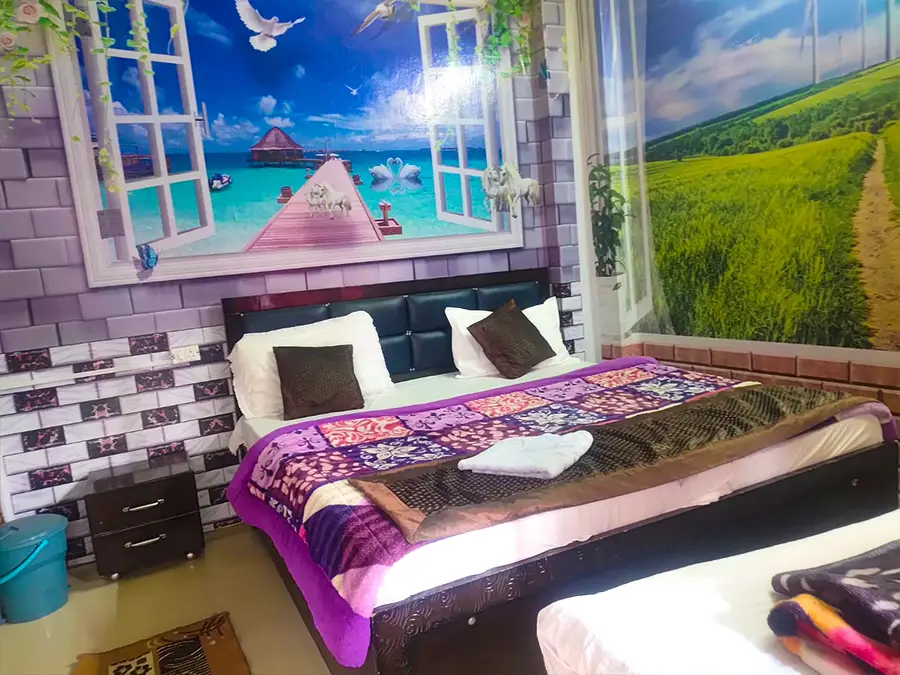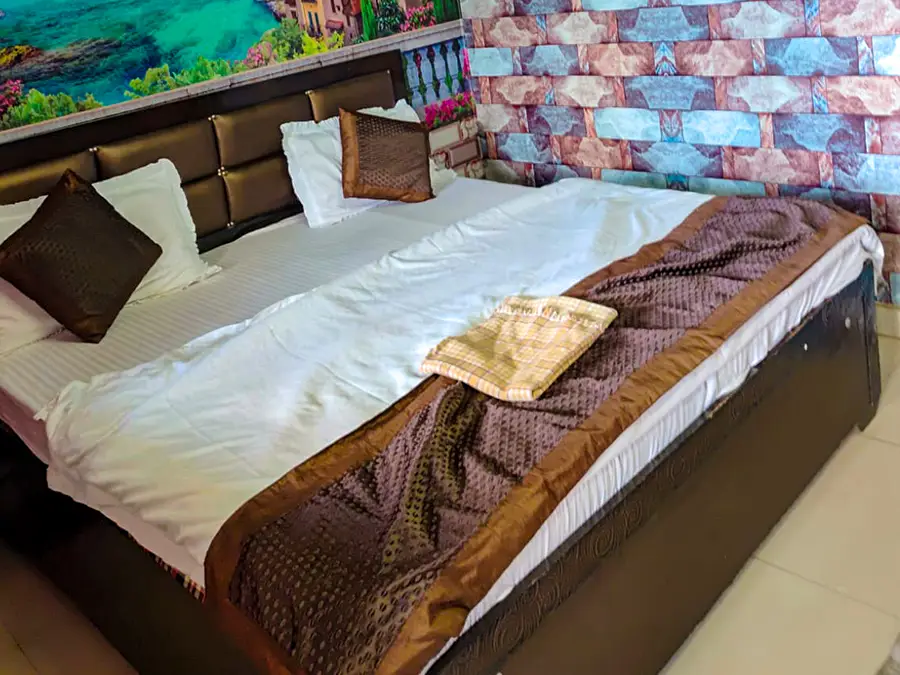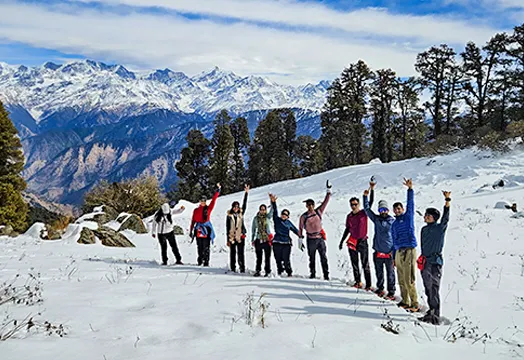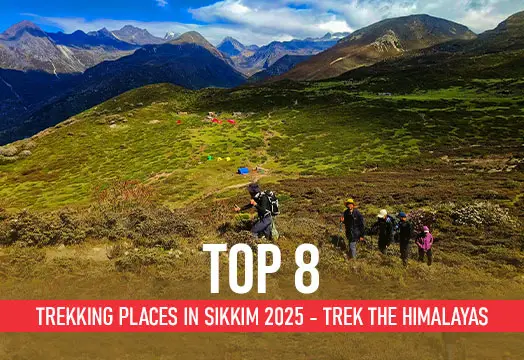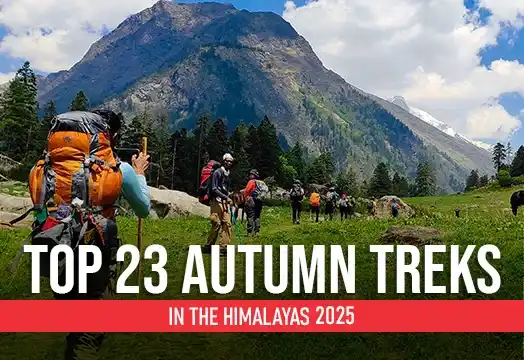Bajre Dara Trek

Region
Sikkim | India

Duration
5 Days

Max Altitude
11000 Ft.

Trekking Km
22 KM

Grade
Moderate
Get in Touch with Our Trek Expert
91 7302321133 info@trekthehimalayas.comMonday - Saturday: 10 AM to 09.30 PM (GMT +5:30)
Sunday: 10 AM to 05.30 PM (GMT +5:30)
12600 /Person
- February-2026
- March-2026
- April-2026
- Pickup & Drop Location: New Jalpaiguri Railway Station
Pickup: 10:00 AM | Drop: 6:30–7:30 PM (weather/road dependent)
Keep a buffer day and arrive a day early to avoid delays. - Services from Yuksom to Khecheopalri
- Base Camp Accommodation: Guest house stay with attached washroom (no bunk beds).
- Complimentary cloakroom at base camp for safe storage.
- Avail Special Casual Leave if you’re a Central Govt. employee.
- Trek again for free
Add-ons
Insurance 200
- Insurance is mandatory.
- It is available for Indian citizens only.
- Non-Indians have to take insurance on their own.
- If you already have the high altitude trekking insurance, email for a refund after booking.
- The cancellation policy will be implemented in accordance with the trek cancellation policy.
- For more details about insuranceclick here
- + 5% GST will be applicable
Transport 3000
- Transportation from NJP to Yuksom and return is optional.
- Choose add-ons during booking. If missed, log in and add them later.
- Book transportation at least 10 days before the trek.
- Cancellation 4 or more days before the start of the trip results in a 100% cash refund.
- Cancellation less than 4 days from the start of the trip results in a 50% cash refund.
- Cancellations made on the trip date are not eligible for a refund.
- + 5% GST will be applicable
Offload 2500
- Backpack offload is optional.
- Choose add-ons during booking. If missed, log in and add them later.
- Book off-load at least 10 days before the trek.
- For offline bookings at the base camp, a convenience fee of Rs. 3000 applies.
- Cancellations made before the trip date will receive a full refund.
- + 5% GST will be applicable
Single Occupancy Tent 2400
- Single Occupancy Tent is optional.
- Choose add-ons during booking. If missed, log in and add them later.
- Book Single Occupancy Tent at least 10 days before the trek.
- Cancellations made before the trip date will receive a full refund.
- + 5% GST will be applicable
Get in Touch with Our Trek Expert
91 7302321133info@trekthehimalayas.com
Monday - Saturday: 10 AM to 06 PM (GMT +5:30)
Overview
Trek Name: Bajre Dara Trek
Days: 5
Adventure Type: Trekking
Base Camp: Yuksom
Season:Autumn | Winter |
Month:January | February | March | October | November | December |
Country: India
Altitude: 11000 Ft.
Grade: Moderate
Rail Head: New Jalpaiguri (NJP)
Stay: Camping(Twin Sharing) & Hotel/Guest House(Separate for male & female))
Food: Meal While on trek & at Hotel/GuestHouse(Veg & Eggs)
Location: Sikkim
Distance: 22 Km.
Trail Type: One way trail | Camping in various locations, starting and ending at the different point.
AirPort: Bagdogra International Airport, which is 20 km away from New Jalpaiguri Railway station
Highlights:
- Pickup & Drop Location: New Jalpaiguri Railway Station
Pickup: 10:00 AM | Drop: 6:30–7:30 PM (weather/road dependent)
Keep a buffer day and arrive a day early to avoid delays. - Services from Yuksom to Khecheopalri
- Base Camp Accommodation: Guest house stay with attached washroom (no bunk beds).
- Complimentary cloakroom at base camp for safe storage.
- Avail Special Casual Leave if you’re a Central Govt. employee.
- Trek again for free
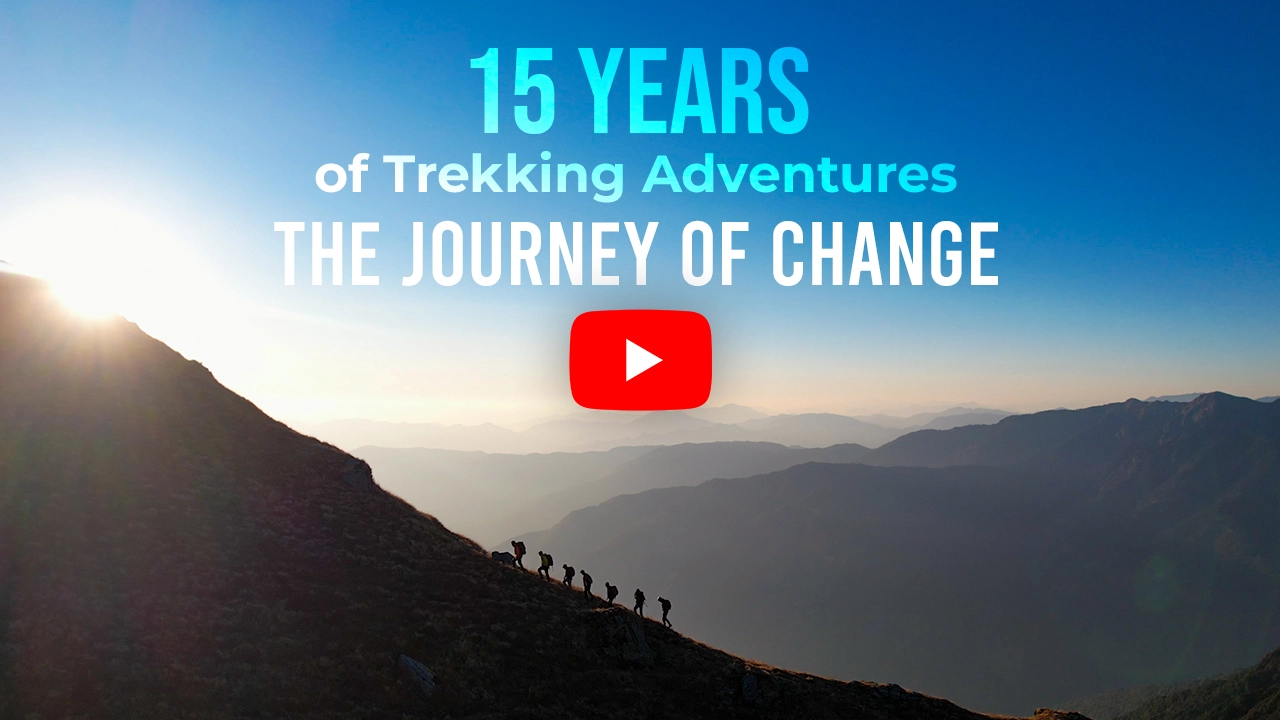
Bajre Dara Trek - The Sikkim’s Treasure
- Yuksom: The trek begins at Yuksom, once the capital of Sikkim. It is the gateway to Kanchenjunga National Park and reveals the state's rich cultural heritage.
- Dubdi Monastery: You can also explore Dubdi Monastery, one of the oldest in Sikkim, and experience the peaceful ambiance of this charming village.
- Bajre Dara Ridge: At 11,000 feet, this ridge is famous for providing panoramic views of the Eastern Himalayas, including the majestic Mt. Kanchenjunga and Mt. Pandim, especially during sunrise and sunset.
- Khecheopalri Lake: Locally known as the "Wish-Fulfilling Lake," this sacred lake is a serene and spiritual spot, believed to grant wishes. Surrounded by dense forests, it is a must-see on the Bajre Dara trek.
- Khecheopalri Monastery: Located near the lake, this monastery adds a spiritual touch to the Bajre Dara trek. It is a peaceful retreat where you can immerse yourself in Sikkim's rich Buddhist culture.
- Dense Forests and Flora: The trek takes you through rhododendrons and bamboo forests, with the possibility of encountering vibrant wildflowers depending on the season.
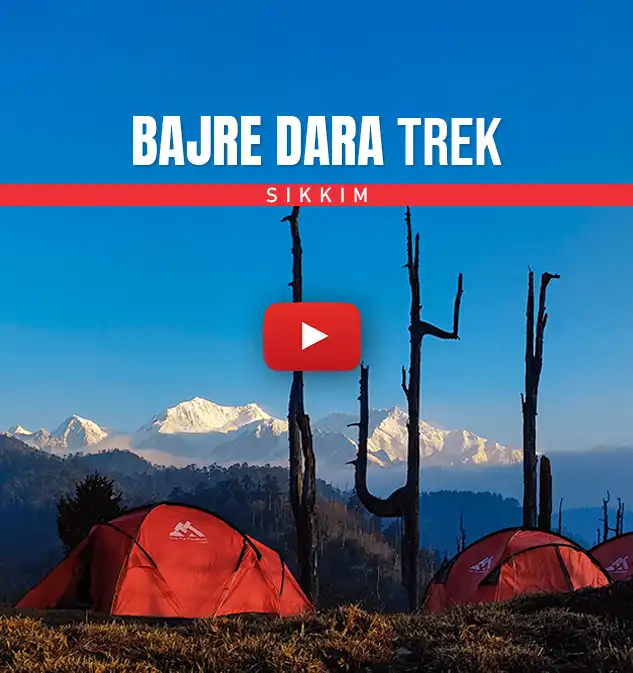
Who Can Participate
- Age Requirement:
- April to November: 10 years.
- December to March: 12 years.
- First-timers are welcome, though prior trekking experience is preferred. Good fitness is a must.
- Fitness Criteria:
- If the trekker wants to carry a backpack then he/she should be able to carry a 10-12 kg backpack. If opt Off-load option then the trekker should be able to carry 3-5 kg backpack.
- If a trekker's BMI is more or less than the normal range (18-28), please consult our Trek Coordinator before booking.
Loved it? Do it again for free!!!
At Trek The Himalayas, we understand that things don’t always go as planned. If you couldn’t complete your trek or just want to experience it once more, we’re giving you a wonderful opportunity – the chance to do the trek again without having to pay the trek fee again.
Pay a one-time fee to select your favourite trek, and you can repeat it as many times as you want within 5 years.

Terms and Conditions:
- The offer is valid for 5 years from the trek departure date.
- Participants are not required to pay the trek cost again, but they will need to cover transportation, insurance, and trek permit costs.
- This offer is non-transferable and is only applicable to TTH's limited fixed departures.
- The offer does not apply if the participant has received a refund, a voucher, or a transfer to another trek that has been used previously.
- The offer will be activated once the participant reaches the trek base camp.
- This is not an offer linked to any purchased package; rather, it is an initiative extended by TTH out of goodwill, without any cost to the trekkers.
- Trek The Himalayas reserves the right to cancel this offer at any time, in case of:
- Disobeying the safety regulations, trekking rules, or the code of conduct
- Black listing due to bad behavior, payment issues, or providing inaccurate information
- Anything that would damage the brand or reputation of TTH
- In order to rebook, just fill in our booking form online or call our team.
Bajre Dara Trek Itinerary
New Jalpaiguri (NJP) to Yuksom
- Altitude Yuksom: 1,800 m / 5,700 ft
- Drive Distance: 150 km | Approx. 8 hrs
- Accommodation: Guest House
- Last ATM point: Legship
- Note: Foreigners will need an Inner Line Permit (ILP) and it is easy to get while entering Sikkim from the nearest Check post. To get it, foreigners must have a valid passport and visa for verification and printed copies for submission.
Your adventure begins with a drive from New Jalpaiguri (NJP) to Yuksom, the starting point of our trek to Bajre Dara. If you've booked transportation with us, our team will pick you up at NJP Railway Station at 10 AM. From here, you will embark on an 8-hour, 150 km journey into the Sikkimese Himalayas.
As the vehicle goes through the winding mountain roads, there’s a noticeable shift. The air feels cooler, the landscape greener, and the anticipation of adventure fills the air. The drive to Yuksom is more than just a commute; it’s the first step into a slower, more peaceful world.
The drive will provide you with glimpses of Sikkim’s untamed beauty. As you ascend, the mighty Himalayan ranges start to appear in the distance, a subtle reminder of the grand adventure awaiting you. The Teesta River, with its roaring, emerald waters, follows alongside you for a while, adding its rhythm to the journey. It’s a constant companion, guiding you toward the mountains.
Halfway through, you’ll stop at Jorthang for lunch. A small town located between hills, it's the perfect place to stretch your legs and enjoy a simple, hearty meal before continuing on. The path ahead becomes more scenic, and soon you’ll cross the Legship Bridge, marking another milestone. It's also your last chance to use an ATM, though, by now, your mind is probably more focused on the mountains than any financial concerns.
Arriving in Yuksom feels like stepping back in time. This town, tucked away in West Sikkim, holds a rich history as the first capital of the kingdom of Sikkim. It’s often referred to as the gateway to Mt. Kanchenjunga. The town exudes a charm with its old wooden houses, narrow streets, and rolling hills. If you reach early, you can explore Yuksom's hidden gems, including some of the oldest monasteries in Sikkim. Visiting these ancient monasteries is like peeling back layers of history, where every prayer flag and every stone seems to tell a story of the region’s deep cultural and spiritual roots.
You’ll be accommodated in a cozy guesthouse, where you can rest and prepare for the trek ahead. If you need to pick up any last-minute supplies for the trek, Yuksom has provisions for trekkers. In the evening, the trek leader will hold a briefing session, explaining the rules and guide for the trek, the weather conditions you might face, and the essential gear you need to carry. This is also the perfect time to share any health concerns or conditions with the leader to ensure your safety during the trek.
As you settle into Yuksom for the night, you can feel the calm wash over you. There’s something about the place, perhaps it’s the connection to Sikkim’s past, or the mountains towering in the distance. Either way, it’s the perfect beginning to what’s going to be an unforgettable trek. If you’re lucky, the evening might greet you with a soft mountain breeze, carrying the faint sound of monastery bells and the smell of pinewood.
Tomorrow, the real adventure begins. But tonight, let Yuksom be a gentle introduction to the magic that awaits.
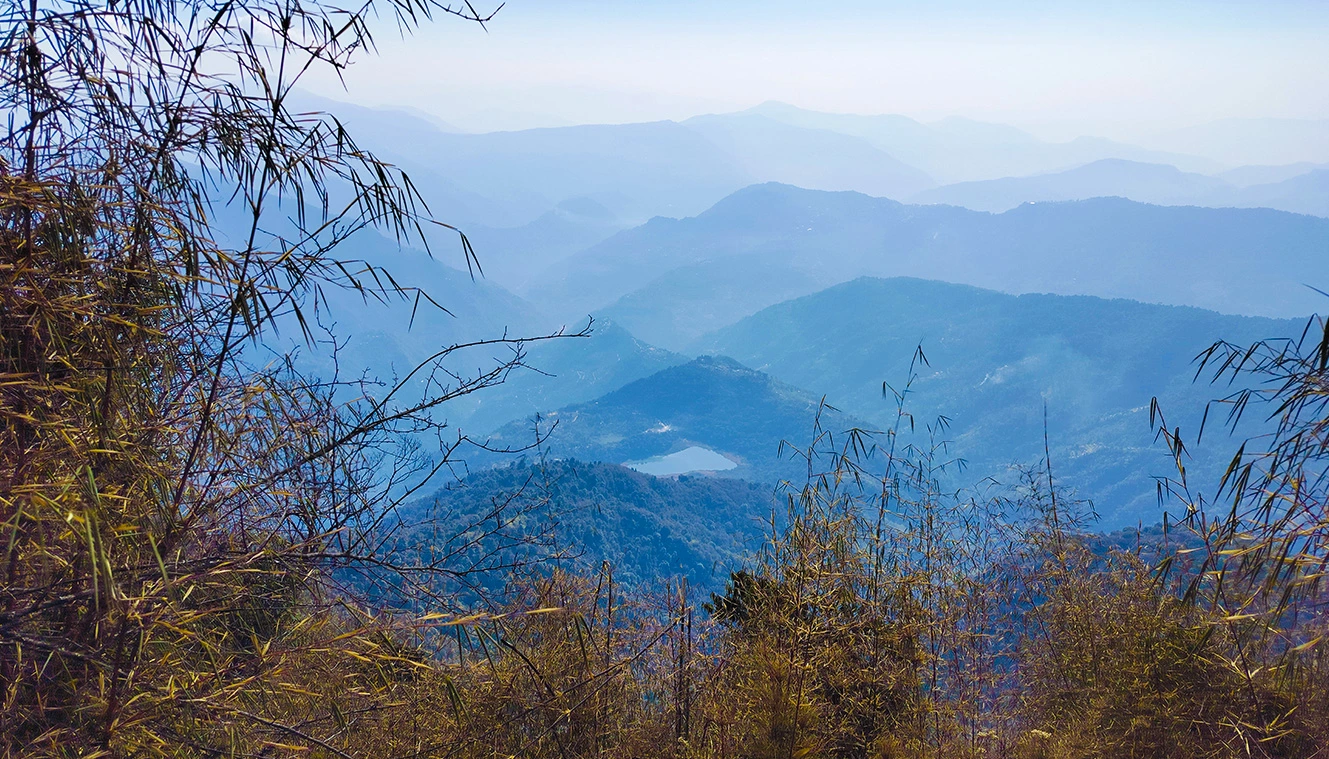
Drive from Yuksom to Melliaching and Trek to Bhanjang via Pangretar
- Altitude:
- Melliaching: 1,800 m / 5,800 ft
- Bhanjang: 2,500 m / 8,200 ft
- Drive Distance: 20 km | 2 hrs
- Trek Distance: 7-8 km | 6-7 hrs
- Accommodation: Tent
Today marks the true beginning of your Bajre Dara Trek, and the excitement will build as you step into the wild beauty of Sikkim.
You will start with an early morning drive from Yuksom to Melliaching, a cliffside village about an hour away. Melliaching, known for its views of the valley below, feels like a portal to another world. This village is also home to one of Sikkim’s oldest monasteries, Melli Gompa, and will serve as the starting point of the trek.
From here, you begin your trek to Bhanjang, located deep within a dense tropical forest. The trail starts relatively flat, making for an easy walk towards Pangretar, a small settlement with traditional architecture, and mountain views accompanying you at every turn. The wooden trail ahead leads into a forest thick with oak, green oak, argeli, and bamboo grass. Depending on the season, you might even spot beautiful wildflowers along the way.
The first leg of the trek to Pangretar is gentle, and you’ll pass through small hamlets like this, where you can pause and take in the serenity of the surrounding valley. Here you will find a waterpoint available at Pangretar. The trail gradually ascends, leading to the day's main challenge that is Gayjure, a steep, poorly defined hump that tests you but rewards you with views of Yuksom and Lamathang.
After a good stretch of trekking, you will stop for a packed lunch before continuing to Bhanjang. The descent into the campsite at Bhanjang, 1.5 km past Gayjure, feels like stepping into a hidden world, surrounded by towering trees and the peaceful hum of the forest. This small, tucked-away campsite is truly special.
Once you settle in, you’ll have time to explore the area. Just a 10-minute walk from the campsite is a stunning viewpoint that provides views of sunsets if the weather permits. On clear days, you can even spot Khecheopalri Lake shimmering far in the distance. The sunset here is nothing short of magical, casting an orange glow over the surrounding hills and making the evening feel otherworldly.
After a day of trekking through rich forests and mountain landscapes, you’ll enjoy your first night camping under the stars at Bhanjang.
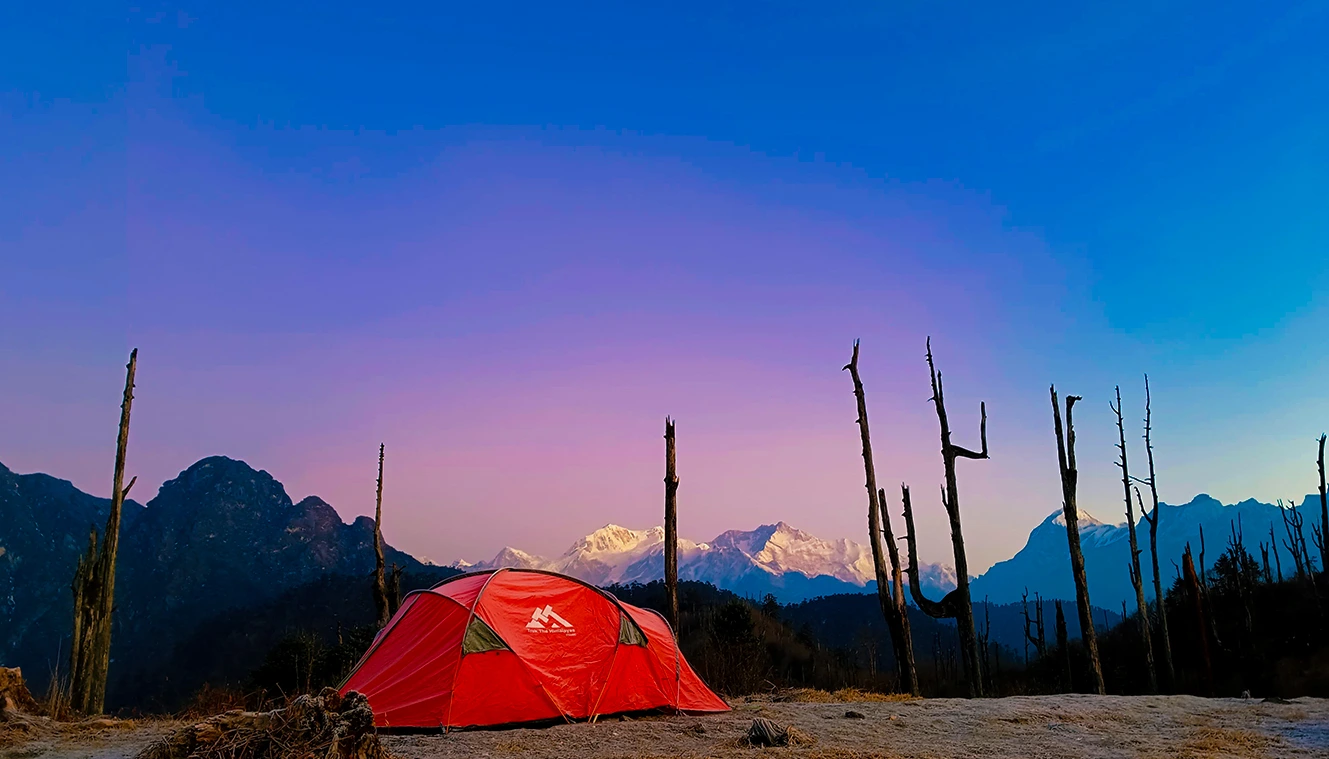
Trek from Bhanjang to Bajre Dara
- Altitude Bajre Dara: 3,400 m /11,000 ft
- Trek Distance: 4 km | 6-7 hrs approx.
- Accommodation: Tent
This is one of the most exhilarating days of your trek as you make your way from Bhanjang to the summit of Bajre Dara. You start early, with the cool morning air energizing you for the challenging journey ahead. The trail is a mix of steady and steep climbs, winding through the wilderness of Sikkim.
As you begin, the narrow path takes you through an enchanting rhododendron forest, the trees towering above you like silent guardians of the trail. Soon, you will be into a bamboo forest, where the green undergrowth and occasional breaks in the canopy provide glimpses of the snow-capped mountains in the distance. The climb today is challenging, with some steep ascents and narrow, scree-filled trails that will push you physically. But each step brings you closer to Bajre Dara, and the effort is well worth it.
With no water points along the way, make sure to carry enough water from the campsite, as today’s climb can be tiring. We’ll take breaks as needed, with a packed lunch to keep us fueled for the day. The trail may feel tough, but the changing landscape, the vibrant colors of the forest, and the camaraderie of the group make it a wonderful experience.
While you ascend, the forest gradually opens up, and the trail becomes more exposed. The final stretch is a steady push to reach Bajre Dara, the highest point of the trek. The views from here are simply amazing. On clear days, you’ll be greeted by the peaks of Kanchenjunga, Mt. Pandim, Rathong, Talung, Kabru Dome, Black Kabru, and Mt. Kabru. If the weather permits, you might also spot Khecheopalri Lake, shaped like a foot, shimmering in the distance, a truly magical sight.
Bajre Dara feels like a place suspended between heaven and earth. The air is icy and fresh, and if you look around, you might see some old tree trunks, shaped by lightning strikes from long ago, silent witnesses to the power of nature.
The night gives way to dawn, and you’ll witness one of nature’s most breathtaking spectacles, the best sunrise and alpine glow on Kanchenjunga. The first rays of sunlight gently kiss the towering peaks, illuminating them in hues of gold and pink, a sight that will stay with you forever.
You will camp overnight at Bajre Dara, with the stars above you and the quiet hum of the forest surrounding, ending the day on a peaceful note.
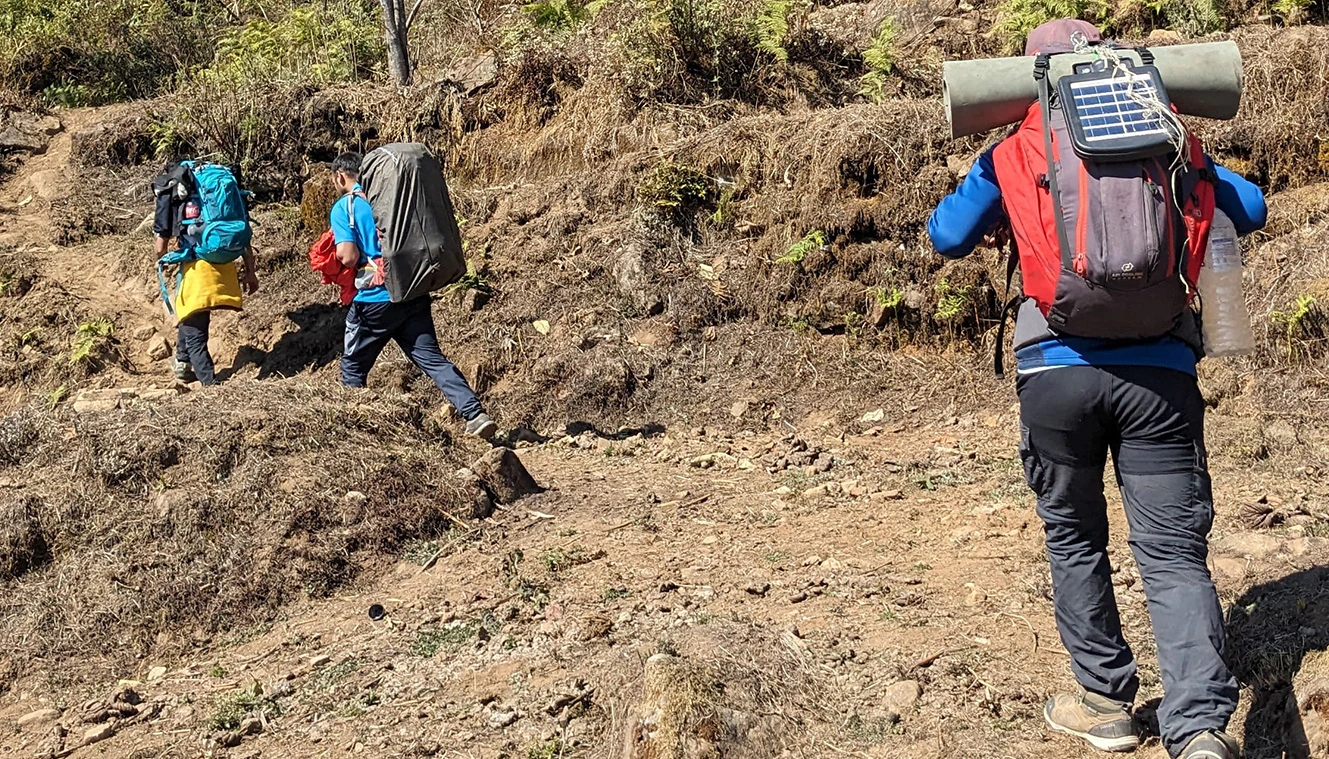
Trek from Bajre Dara to Lamathang
- Altitude Lamathang: 2,100 m / 6,900 ft
- Trek Distance: 6 km | 5-6 hrs
- Accommodation: Tent
The dawn breaks, and you’ll want to rise early to witness the best sunrise and alpine glow on Mt. Kanchenjunga. The soft golden rays illuminating the snow-capped peaks create a mesmerizing sight, marking one of the most rewarding moments of our trek. Standing at Bajre Dara, you can feel the chill of the morning air while soaking in this serene beauty—a moment that resonates deeply with the heart and soul.
After this magical experience, you will gather for a hearty breakfast before setting off on your journey to Lamathang village. The day ahead begins with a steep descent, so it’s important to take it slow and steady to protect your knees and avoid injuries. The path, though challenging, is surrounded by rich flora such as saal, chestnut, molshree, bamboo grass, argeli, and various types of ferns, making the trek a visual treat for nature lovers.
You will retrace your steps through the bamboo and rhododendron forests and you will pass by Bhanjang once more. Approximately 600 meters below Bhanjang, there’s a drinking water source where you can refill your bottles before continuing. Unlike your previous route, today’s path veers left at Bhanjang, a different trail that leads us toward the next campsite, Lamathang.
On the descent you will enjoy a packed lunch along the way, savouring the meal while taking in the stunning views of the valley below. Keep an eye out for the beautiful, foot-shaped Khecheopalri Lake, which glistens in the sunlight as you make your way down. Along the way, keep an eye out for the sparkling foot-shaped Khecheopalri Lake, which glistens under the sunlight and adds a magical touch to your journey.
After the trek, you will finally reach Lamathang village, surrounded by greenery and cardamom plantations. This peaceful haven is an ideal spot to unwind and explore. The village, though small with only a few houses, has a welcoming charm and even features a primary school. Take a moment to appreciate the simplicity of life here, soaking in the rural atmosphere and perhaps even engaging with the friendly locals. Tonight, you will settle down in Lamathang, and end the day’s adventures to fade into a serene evening under the stars.
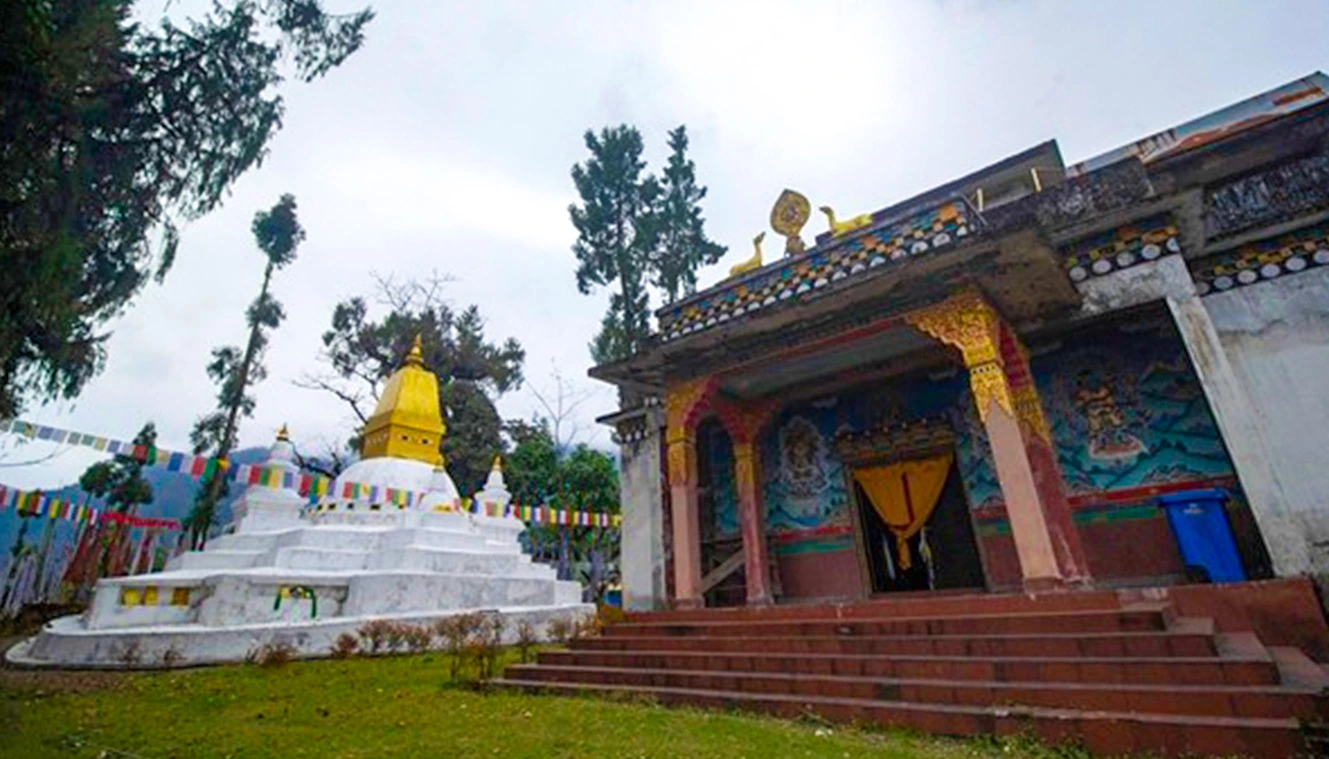
Lamathang to Khecheopalri Lake and Drive Back to NJP
- Altitude Khecheopalri: 2,000 m / 6,500 ft
- Trek Distance: 4 km | 1-2 hrs
- Drive Distance: 170 km | 7-8 hrs
You will wake up to the final day in this enchanting landscape. Today promises to be the most relaxed and enjoyable day of the trek as you make your way through mixed terrain with both steep ascents and descents. You will visit the Khecheopalri Monastery, one of Sikkim's oldest and most revered spiritual sites, and the legendary Khecheopalri Lake, also known as a “wish-fulfilling lake” by locals. Its unique footprint shape and waters create a serene atmosphere, perfect for reflection.
The calm waters of Khecheopalri Lake are said to grant wishes to those who visit, and it's hard not to feel a sense of peace as you stand by its banks. Here, you can take your time to soak in the beauty of the surroundings, snap some photos, or even enjoy a moment of quiet meditation by the water.
The trek concludes here, where our vehicles will be waiting for you at the roadhead, ready to take you back to NJP. On the return drive, you’ll pass through Pelling, a small town known for its stunning views of the snow-capped Kanchenjunga and serene monasteries.
Continuing the journey, you’ll traverse Geyzing, the district headquarters, where you can experience the calmness of Sikkim’s rural landscape. As we pass through Legship, the gateway to western Sikkim, you'll see its famous riverside and sacred sites. With drive, the serene Teesta River will accompany you for much of the journey, its shimmering waters reflecting the beauty of the surrounding landscape, a reminder of the natural wonders you’ve experienced over the past few days.
The journey is a picturesque one, winding through lush valleys, villages, and verdant forests that will leave you with final glimpses of Sikkim's charm. Expect to reach NJP by the late afternoon or early evening, depending on the traffic and road conditions.
Once you arrive in NJP, you may wish to spend the night before continuing your onward journey. If time permits, you can explore the bustling local markets like Hong Kong Market and Bidhan Market, where you can pick up souvenirs and local handicrafts. Don’t miss the chance to indulge in some local cuisine at the eateries around, you’ll find everything from momos to thukpa, a perfect way to end your trip.
Your adventure in the Himalayas comes to an end, you’ll carry with you not just memories of the majestic mountains and serene lakes, but also the deep connection forged with nature and the local culture. Safe travels as you move forward on the next leg of your journey!
Day-1: New Jalpaiguri (NJP) to Yuksom
- Altitude Yuksom: 1,800 m / 5,700 ft
- Drive Distance: 150 km | Approx. 8 hrs
Day-2: Drive from Yuksom to Melliaching and Trek to Bhanjang via Pangretar
- Altitude:
- Melliaching: 1,800 m / 5,800 ft
- Bhanjang: 2,500 m / 8,200 ft
- Trek Distance: 7-8 km | 6-7 hrs
- Drive Distance: 20 km | 2 hrs
Day-3: Trek from Bhanjang to Bajre Dara
- Altitude Bajre Dara: 3,400 m /11,000 ft
- Trek Distance: 4 km | 6-7 hrs approx.
Day-4: Trek from Bajre Dara to Lamathang
- Altitude Lamathang: 2,100 m / 6,900 ft
- Trek Distance: 6 km | 5-6 hrs
Day-5: Lamathang to Khecheopalri Lake and Drive Back to NJP
- Altitude Khecheopalri: 2,000 m / 6,500 ft
- Trek Distance: 4 km | 1-2 hrs
- Drive Distance: 170 km | 7-8 hrs
Bajre Dara Trek Graph
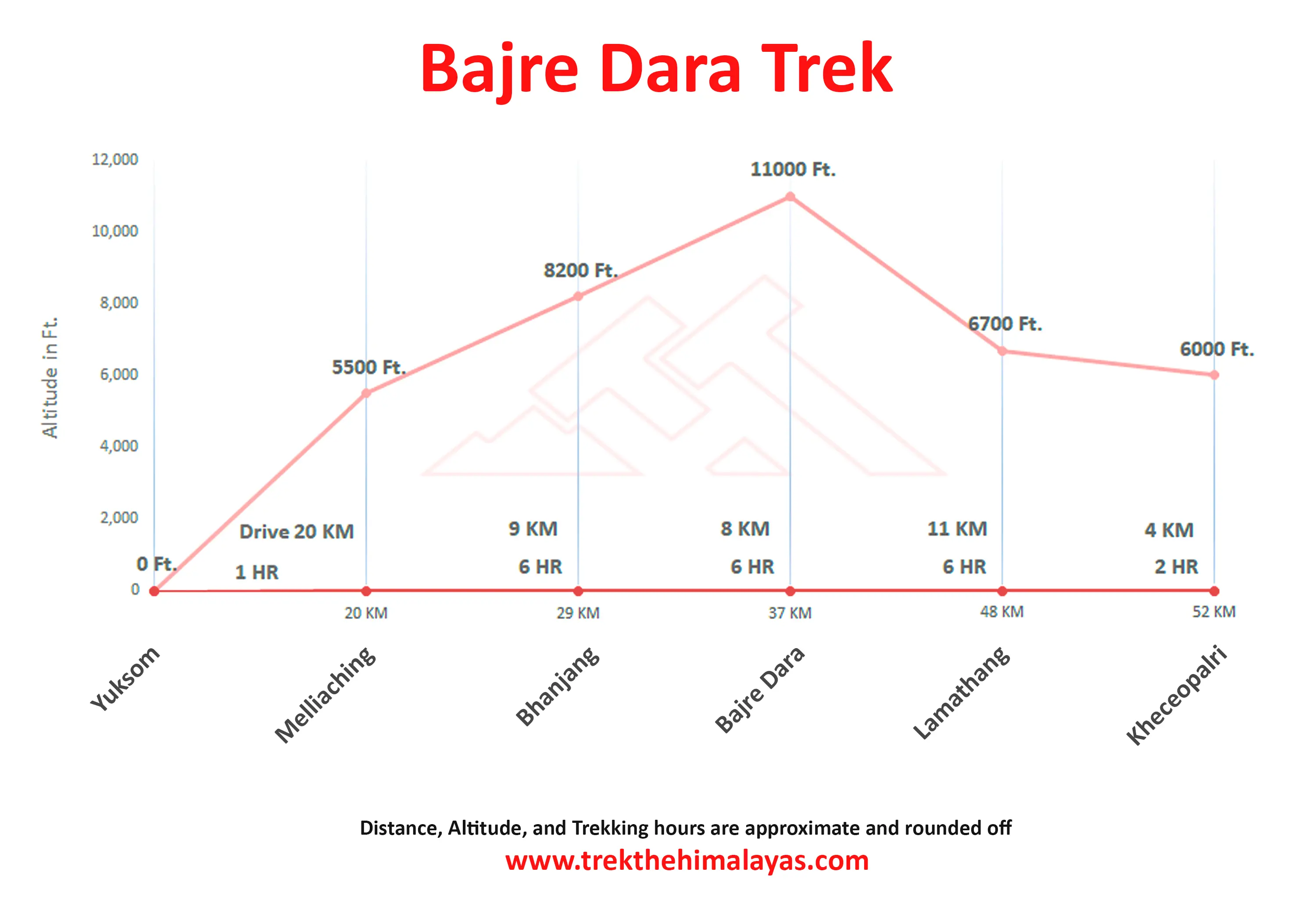
.webp)
- Pulse rate at rest must be in between (60 to 100 beats per minute).
- Blood Pressure Reading must be in between (DIASTOLIC 75 – 85, SYSTOLIC 100 - 130 mm Hg).
- Respiratory rate at rest must be in between (12 to 20 breaths per minute).
- Should not have Liver and kidney issues.
- Should not have Diabetes Mellitus, Bronchial Asthma, Heart problems, Hypertension, etc.
- No pacemaker implant.
- People with Sinus issues, Epilepsy please contact to trek coordinator before booking the trek.
- If your BMI is not normal, Please contact our Trek coordinator before Trek booking.
Medical & Disclaimer Form (Mandatory Documents) Click here to download Medical & Disclaimer Form
Government employees can avail the benefit of Special Casual Leave (SCL) when they join us for a trekking expedition. As per Pay Commission guidelines, up to 30 days of Special Casual Leave can be availed in a calendar year for trekking or mountaineering expeditions conducted through a registered organisation.
Trek The Himalayas is a registered adventure tour operator with the Indian Mountaineering Foundation (IMF) and the Ministry of Tourism (MoT), making your trek eligible for SCL benefits.
To apply, email us at info@trekthehimalayas at least 20 days before the trek departure date, with the following details:
- Trek name and trek date
- Booking details
- Full name
- Designation
- Department and department address
This benefit is exclusive to Indian Government employees and is applicable only for treks within India.
- Junior trekkers (below 15 years) should have a company of parents/guardians.
- Trekkers between 15 to 18 years can come solo with the disclaimer form signed by parent/guardian.
- Medical & Disclaimer Form (Mandatory Documents) Click here to download Medical & Disclaimer Form
Important Links
- Mandatory Documents to Bring on A Trek Click Here.
- How to pay Add-ons, Submit Medical Forms, and Dietary Preferences Click Here to watch Video
How To Reach
It is essential for everyone to arrive at New Jalpaiguri Junction (NJP) (10:00 am)
Once you have reached New Jalpaiguri Junction (NJP), TTH will manage the rest of your travel arrangements, if you have opted for TTH's pick-up service, you can select this option during the booking process by adding it as an add-on.
Options to reach New Jalpaiguri Junction (NJP) railway station.
1. Take a flight to Bagdogra Airport in West Bengal, and take a cab to NJP railway station, it’s 20 km away and will take 40 minutes.
- Domestic: There are various direct and indirect flights from other cities. You can take direct flights from Delhi, Kolkata, Guwahati and other cities.
- International: International terminal is well equipped with modern amenities. Druk Air is the airline which provides international flights to the passengers. International flights connect with Paro in Bhutan and Bangkok. These flights are direct and comfortable.
2. Take a train to New Jalpaiguri Junction (NJP) that is well-connected to major cities like Kolkata, Guwahati, Delhi and Mumbai.
( If you prefer to travel independently, you can either take a government bus or book a private cab. Your trek coordinator will provide guidance on how to arrange for the bus or cab booking. )
Drop-Off Information
- Arrive in New Jalpaiguri (NJP) by 6:00 pm to 7:00 pm.
- The designated drop-off point is NJP railway station.
- Please consider planning your subsequent travel arrangements after 5:30 pm.
- The distance from Railway Station to Bagdogra Airport is 20 km, it will take approx 40 minutes.
- TTH offers comfortable transportation through Xylo, Bolero, or equivalent vehicles. If you wish to upgrade your mode of transportation, please contact your trek coordinator for further assistance.
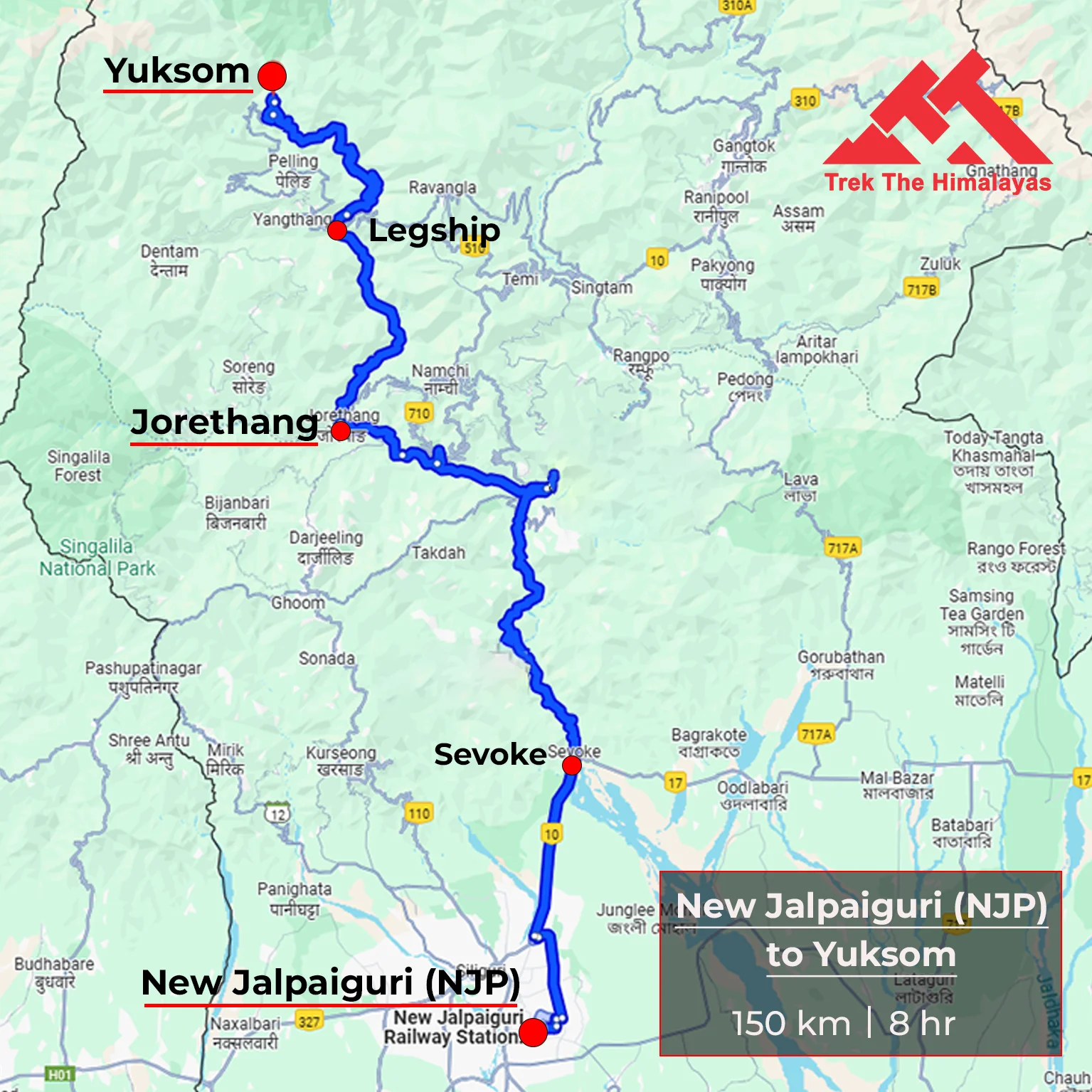
Cost Terms
Inclusion
1. Insurance is Mandatory.
2. Accommodation (as per the itinerary):
- Guest houses on Day 1 (Triple/quad sharing).
- Camping during the trek (Day 2 to Day 4).
3. Meals (Veg + Egg):
- All meals are from Yuksom to Lamathang.
- Day 1 Dinner to Day 5 Breakfast.
4. Support:
- 1 Versatile base camp manager handles communication and deploys extra manpower in emergencies.
- 1 Mountaineering & First aid qualified professional trek Leader.
- 1 Experienced high-altitude chef.
- Local experienced guides (Number of guides depending on the group size).
- Enough support staff.
5. Trek equipment:
- Sleeping bag, Sleeping liners (if required), mattresses, and Utensils.
- 3 men all season trekker tent (twin sharing), Kitchen & Dining tent, Toilet tent.
- Camping stool, Walkie talkie.
- Ropes, Helmet, Ice axe, Harness, Gaiters & crampons (if required).
6. First aid:
- Medical kit, Stretcher, Oxygen cylinder, Blood pressure monitor, Oximeter, Stethoscope.
7. Transportation (as per the itinerary):
- Transport from NJP Station to Yuksom and return to NJP Station (If booked through TTH, available upon booking in add-ons).
8. Mules/porters to carry the central luggage.
9. Cloakroom facility available at the base camp for additional luggage.
10. All necessary permits and entry fees, up to the amount charged for Indians.
11. Services from Yuksom to Khecheopalri.
12. Trek Completion & Certificate.
Exclusion
- Insurance (For non-Indian Nationals, NRI or OCI card holders).
- Food during the transit.
- Any kind of personal expenses.
- Mule or porter to carry personal luggage.
- Emergency evacuation, hospitalization charge, etc.
- Any extra costs incurred due to extension/change of the itinerary due to natural calamities roadblocks, vehicle breakdown, etc. factors beyond our control
- Transport from NJP Station to Yuksom and return to NJP Station (If not booked through TTH).
- Anything not specifically mentioned under the head Inclusion.
Things can be provided on demand and availability (participant has to pay extra for these things).
1- Satellite phone/set phone - a type of mobile phone that connects via radio links via satellites orbiting the Earth instead of terrestrial cell sites like cell phones. Therefore, they can operate in most geographic locations on the Earth's surface.
Note: Satellite phones are prohibited in Leh-Ladakh, Kashmir, and Sikkim due to security concerns related to their proximity to sensitive international borders. Only authorized personnel, like government officials and the military, can use them with special permission from the Department of Telecommunications (DoT).
2- Gamow/PAC HAPO Bag (Portable Hyperbaric Bag) - is a unique, portable hyperbaric chamber for the treatment of acute mountain sickness (AMS), also known as altitude sickness.
3- AEDs (Automated External Defibrillators) - are portable life-saving devices designed to treat people experiencing sudden cardiac arrest, a medical condition in which the heart stops beating suddenly and unexpectedly.
Cancellation Terms
To request a cancellation, please email us at info@trekthehimalayas.com using your registered email ID.
Cancellations prior to 25 days from the start of the Trip
Refund Options
- 5% deduction of trek fee
- 100% trek fee cash voucher for any trip till one year
- Transfer your trek (any trek, any date) to your friend
Cancellation between 24 days and 15 days to the start of the Trip
Refund Options
- 30% deduction of trek fee
- 100% trek fee cash voucher for same trip till one year
- 85% trek fee cash voucher for any trip till one year
- Transfer your trek (same trek, any date) to your friend
Cancellation between 14 days and 10 days to the start of the Trip
Refund Options
- 50% deduction of trek fee
- 80% trek fee cash voucher for same trip till one year
- 70% trek fee cash voucher for any trip till one year
- Book the same trek, in the same season, with any other batch
- Transfer your trek (same trek, any date) to your friend
Cancellation less than 9 days to the start of the trek.
Refund Options
- No cash refund
- 20% trek fee cash voucher for the same trip till one year
- 10% trek fee cash voucher for any trip till one year
- Transfer your trek (same trek, same date) to your friend
- To reschedule a trek (same trek only), a 30 % rescheduling fee of the trek cost will apply.
Cancellation Policy (Emergency Cases):
In case of a death in the immediate family (parents, siblings, spouse, children) or if the trekker is hospitalized (min. 48 hours) or suffers a fracture (leg/arm) within a week before the trek, even if canceled a day before:
90% trek fee refund in cash & 10% as a voucher (valid for 1 year, for any India trek).
Valid documents required. We’re here to support you during tough times.
Note:
- Change of trek batch is dependent on the availability of seats in the batch
- In case of transferring a trek to a friend, he/she should satisfy all the mandatory requirements put forward by TTH
- TTH holds the right to change/cancel the policies, without prior notice
Booking and Payments
- The Participant is responsible for verifying the accuracy of all details, including Trip dates and personal documentation, at the time of booking.
- Payments must be made in accordance with the timelines and instructions provided by TTH. Late payments may result in cancellation of booking without refund.
- In the event of a cash refund, only the portion of the payment made in cash shall be eligible for refund in cash. Any booking made using voucher, discounts, promotional codes, or through any non-cash mode of payment shall not be eligible for a cash refund under any circumstances.
- Refunds, if applicable, shall be processed within 15–30 working days of confirmation.
- All add-on bookings are subject to the respective add-on cancellation policy, and refunds will be processed accordingly.
- Voucher Terms
- This is a non-transferable voucher
- The voucher cannot be merged with any other offer of Trek The Himalayas
- The voucher is valid for Trek booked directly with Trek The Himalayas in India
- To avail the voucher please use your register phone number or e-mail id
- All the other Terms of booking a trek with Trek The Himalayas are applicable to the voucher
Itinerary and Modifications
- TTH reserves the right to modify, shorten, or cancel any part of the Trip due to transportation delays, weather, health emergencies, or other unforeseen circumstances including Force Majeure.
Cancellations and Refunds
- No refunds or vouchers, partial or otherwise, shall be provided for voluntary withdrawal, non-utilisation of services, or removal from the Trip.
- If TTH cancels the Trip before arrival at the designated pick-up point due to unforeseen circumstances or Force Majeure, the Participant may choose from:
- An alternate Trip/date.
- A credit voucher valid for one (1) year.
- Transfer to another Trip, with cost differences payable by the Participant.
- If the Trip is abandoned post-arrival at the designated pick-up point, no cash refund or voucher shall be issued. The Trek Again Policy may apply at TTH’s discretion.
- TTH shall not be liable for any associated travel costs such as flights, accommodation, or visa fees.
Force Majeure
- Events beyond its control including but not limited to earthquakes, landslides, strikes, curfews, war, pandemic, government restrictions, heavy rainfall or snowfall, windstorms, road blockages, trail disruption, or withdrawal of permits, TTH shall not be held liable for any cancellation, delay, or service modification caused by Force Majeure.
Trek Essentials
Rent EquipmentPDF Of Trek Essential Download
| Backpack with rain cover | (50 - 60 ltr) with comfortable shoulder straps |
| Day pack with rain cover | 20 - 30 ltr (If off-load opted) |
| Walking stick | Advisable (At least one) |
| Water Bottle / Hydration pack | 2 thermos flask bottles of one liter each, Avoid hydration pack. |
| Small size tiffin/lunch box | 1 Nos |
| Snacks | Energy bars, dry fruits, electral/ors |
| Personal Medical Kit | Consult your doctor |
| T-Shirt (Synthetic quick dry) | 1 Full & 1 Half sleeves |
| Fleece T-shirt | 2 Nos |
| Fleece jacket | 1 Nos |
| Windproof Jacket | 1 Nos |
| Down feather / Hollow jacket | 1 Nos. |
| Thermal inner (Upper and Lower) | 1 Pair |
| Trek Pant (Synthetic quick dry) | 1 Nos. |
| Fleece Pant | 1 Nos |
| Waterproof gloves | 1 Pair |
| Fleece / woollen gloves | 1 Pair |
| Poncho / waterproof Jacket and pant | 1 Nos. |
| Sunscreen | 1 Nos. |
| Moisturiser | 1 Nos. |
| Chap-stick / Lip balm | 1 Nos. |
| Toothbrush and toothpaste | 1 Nos. |
| Toilet paper & Wipes | 1 Nos. |
| Hand sanitizers | 1 Nos. |
| Antibacterial powder | 1 Nos. |
| Quick dry towel | 1 Nos. |
| Head torch | 1 Nos. (Avoid Hand torch) |
| Sun Cap | Not required |
| Woolen cap | 1 Nos. |
| Balaclava | 1 Nos. |
| Buff / Neck-gaiters | 2 Woollen |
| Sunglasses | UV with dark side cover, People who wear spectacles - (A)- Use contact lenses | (B)- Photo chromatic glasses |
| Trekking shoes | 1 Pair (Water-resistant, high ankle, good grip) |
| Floaters / flip-flops | Not required |
| Cotton socks | 4 pairs |
| Woollen socks | 3 pairs |
| Gaiters | 1 Pair (TTH provides when required) |
| Micro spikes | 1 Pair (TTH provides when required) |
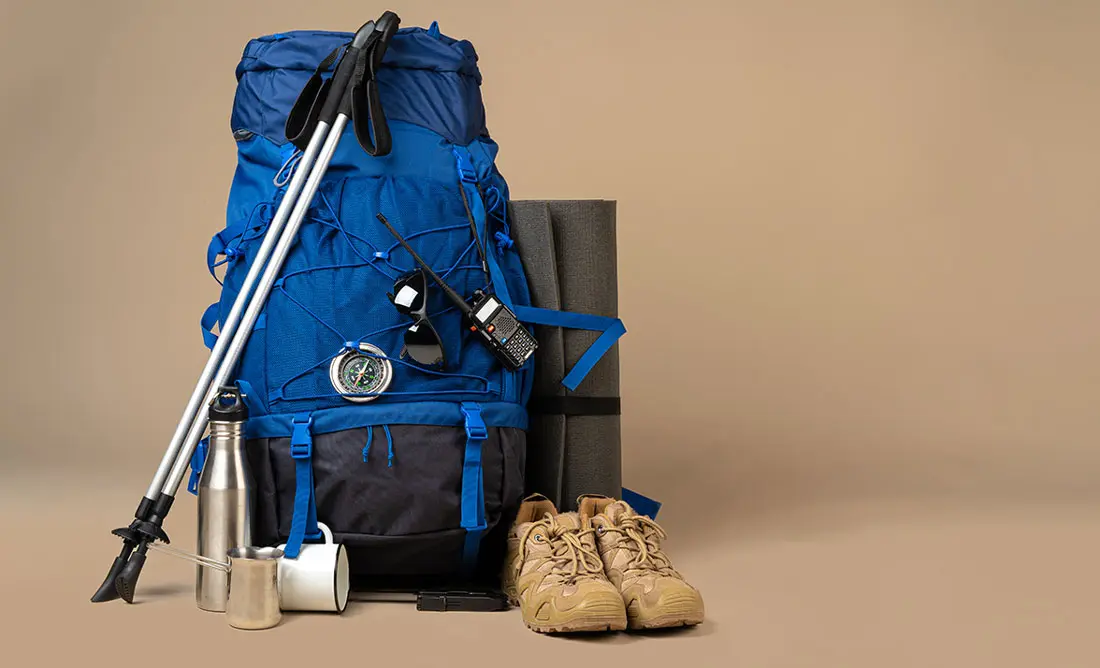
Frequently Asked Questions(FAQ)
To register with TTH, visit our website - www.trekthehimalayas.com and create your account. To create your account you will need to use your email address and fill in all the details, set your unique password and your account is ready to use.
- To book a trek with TTH, you first need to register with us and create an account.
- Choose the trek that you want to do and click on available dates.
- You will land at the login page, fill in the required details.
- Add Participants, choose add-on services click on the Pay now button, choose your preferred payment method, and make the payment. TTH accepts multiple payment options, including credit/debit cards, net banking, and UPI.
- You will receive a confirmation email from TTH with all the necessary details about the trek, including the meeting point, transportation, accommodation, and other important instructions.
- Click Here to watch Video
please send an email to us at info@trekthehimalayas.com or reach out to the numbers provided in the Help and Support section of your Trek Page. We will ensure that your issue is promptly resolved.
To book services such as off-load luggage and transportation, you can find them listed as add-ons. These additional services can be booked at the time of your initial booking. If you miss booking add-ons during the initial reservation, you can log in anytime and easily book 4 days before the departure date add-ons through the platform.
If you have booked the wrong trek or selected the wrong date, don’t worry! You can contact us at +91 9368882322 (Monday to Saturday, 10 AM to 10 PM) or email us at info@trekthehimalayas.com. You can also discuss this with your trek coordinator. Please make sure to inform us at least 10 days before the departure of your trek. Only then can we help you reschedule or arrange another trek for you.
We recommend visiting our "Suggest Me a Trek" page. By filling out the form, our experts will contact you with the best possible trek options based on your preferences and experience level. Alternatively, you can reach out to us via email at info@trekthehimalayas.com or give us a call using the numbers provided on our website for personalized assistance and recommendations.
Family treks differ from regular treks by focusing on ease of difficulty, offering shorter durations for younger participants, Kid-friendly and easily digestible foods, child-friendly activities, maintaining a higher guide ratio for diverse age groups, and implementing additional safety measures for families.
Family Trek with Kids recommendation Only Dayara Bugyal and Chopta Chandrashila Trek.
Minimum age for TTH treks is typically 7 years, though this may vary depending on the specific trek.
Yes, you can take a kids to a high-altitude trek with a parent. Discuss with a trek expert before booking a trek.
- Junior trekkers (below 15 years) should have a company of parents/guardians.
- Trekkers between 15 to 18 years can come solo with the disclaimer form signed by parent/guardian.
- Medical & Disclaimer Form (Mandatory Documents) Click here to download medical and disclaimer form
Physical Fitness: Ensure your child is physically fit. Engage them in regular exercise, outdoor activities, and hikes to build stamina and endurance. Hydration: Emphasize the importance of staying hydrated at high altitudes. Encourage your child to drink water regularly, even if they don't feel thirsty. Proper Nutrition: Provide a well-balanced diet with sufficient carbohydrates for energy and foods rich in iron to prevent altitude sickness. Adequate Sleep: Ensure your child gets enough sleep in the days leading up to the trek. Quality rest is crucial for altitude adaptation. Educate on Altitude Sickness: Teach your child about the symptoms of altitude sickness, such as headache, nausea, and dizziness. Encourage them to communicate any discomfort immediately. Appropriate Clothing and Gear: Dress your child in layers to adjust to changing temperatures. Ensure they have appropriate trekking gear, including sturdy footwear. Positive Mindset: Foster a positive mindset. Encourage your child, and let them know it's okay to take breaks when needed. Medical Check-Up: Schedule a medical check-up before the trek to ensure your child is fit for high-altitude activities. Consult with a healthcare professional about any potential health concerns.
TTH takes special care to provide wholesome and nutritious food for children on treks. Here are some of the foods that are typically served for children:
Breakfast: For breakfast, TTH serves a variety of options like porridge, cornflakes, bread, butter, jam, honey, boiled eggs, omelettes, and pancakes. Children can choose from these options to fuel themselves for the day's trek.
Lunch: For lunch, TTH serves lunch which includes rotis, vegetables, rice, dal, and salad. The rotis are usually made fresh on the trek and are a good source of carbohydrates. The dal and vegetables provide protein and other essential nutrients.
Snacks: TTH provides healthy snacks like fresh fruits, dry fruits, energy bars, cookies, and biscuits to keep the children energized throughout the day.
Dinner: For dinner, TTH serves a hot and wholesome meal which includes soup, rice, dal, vegetables, and a non-vegetarian dish (if requested in advance). Children can also choose from a variety of desserts like custard, jelly, and fruit salad.
Dietary requirements: If a child has any special dietary requirements, TTH can cater to those needs as well. For example, if a child is lactose intolerant or allergic to nuts, the kitchen staff can make arrangements to accommodate those requirements.
Choosing the right trek for a beginner can be a bit overwhelming as there are many factors to consider such as distance, elevation gain, terrain difficulty, weather, and time of year. Here are some tips that can help you choose the right trek for a beginner:
1. Determine fitness level: Assess the fitness level of the beginner to understand their physical capabilities. This will help you select a trek that is challenging but not too difficult.
2. Choose a well-traveled trail: A well-traveled trail will have more amenities such as signposts, water stations, and shelter. It is also safer as there will be other hikers on the trail.
3. Consider the length of the trek: For beginners, it is recommended to start with a shorter trek that can be completed in a day or two. This will help them get acclimatized to trekking and build their confidence.
4. Look for gradual elevation gain: Choose a trek with a gradual elevation gain rather than steep ascents. This will make the trek easier and more enjoyable.
5. Check the weather: Check the weather forecast before selecting a trek. Avoid treks during the monsoon season or winter when the trails can be slippery or dangerous.
6. Research the trail: Read about the trail to get an idea of the terrain, altitude, and difficulty level. This will help you select a trek that is suitable for the beginner.
7. Consult with an expert: If you are unsure about which trek to choose, consult our trek expert Mr. Nitin (+91 70600 59773) between 10 AM to 6 PM (Tuesday - Friday). Mr. Nitin will provide you valuable advice and guidance.
Overall, it is important to choose a trek that is enjoyable, challenging but not too difficult, and suitable for the beginner's fitness level and experience.
It is not recommended for a beginner to choose a difficult Himalayan trek. Trekking in the Himalayas can be physically and mentally challenging, especially if you are not used to the high altitude, steep slopes, and rugged terrain. Choosing a difficult trek without the proper experience, fitness level, and preparation can be dangerous and put you at risk of altitude sickness, injury, and other hazards.
If you are a beginner, it is recommended to start with an easier trek and gradually build up your skills and experience. This will help you understand the challenges of trekking in the Himalayas, and also prepare you physically and mentally for a more difficult trek in the future. It is also important to choose a trek that matches your fitness level, experience, and interest.
There is no specific age limit for a beginner trekker. However, it is important to consider your physical fitness, health condition, and personal interests before embarking on a trek. Trekking in the Himalayas can be physically and mentally demanding, and requires a certain level of physical fitness and endurance.
If you have any pre-existing medical conditions or are above a certain age, it is recommended to consult with a doctor before embarking on a trek. It is also important to listen to your body and take breaks as needed during the trek to prevent exhaustion or injury.
We recommend visiting our "Suggest Me a Trek" page. By filling out the form, our experts will contact you with the best possible trek options based on your preferences and experience level. Alternatively, you can reach out to us via email at info@trekthehimalayas.com or give us a call using the numbers provided on our website for personalized assistance and recommendations.
Yes, you can join the trek. We have fixed departure groups where you can simply book your trek and we will take care of curating a group.
Before you start the trek, it is recommended that you make all the necessary phone calls as during the trek you may or may not receive network coverage, once you come back to the Base Camp, you can reconnect with your family via phone once again. You can share your trek coordinator contact detail with your family members to get the latest updates about your trek batch.
At TTH, we provide wholesome and nutritious meals during the trek. The food is vegetarian and includes a variety of dishes such as rice, dal, vegetables, chapati, paratha, pasta, noodles, and soup. We also offer snacks such as biscuits, and salty, and dry fruits during the trek. Special dietary requirements such as vegan, gluten-free, or Jain food can also be arranged if informed in advance.
If you are allergic to some foods, you need to let us know in advance so that we can make arrangements accordingly.
TTH is a trekking company that prioritizes the safety of all its participants, including women trekkers. We have a comprehensive safety system in place, which includes a dedicated team of experienced and trained trek leaders and support staff who are equipped to handle emergency situations and provide first aid.
TTH also takes specific measures to ensure the safety and comfort of women trekkers. They have a separate tent accommodation for women trekkers, female trek leaders, and support staff. They also provide separate toilet facilities for women and encourage a safe and respectful environment for all trekkers.
Moreover, TTH has a strict policy against any kind of harassment and has a zero-tolerance policy towards such incidents. They have a designated Internal Complaints Committee (ICC) to investigate and address any complaints related to harassment or misconduct. Overall, TTH has a good reputation for safety and responsible trekking practices, and women can feel comfortable and safe while trekking with them.
In case you are the only women in the group, we provide a single sleeping arrangement. Also, during the trek, the trek leader will always remain by your side to provide optimum safety and reassurance.
You can reach out to the trek coordinator to inquire about the number of female trekkers and their respective states who have booked the trek. Please note that the trek coordinator cannot disclose personal details of any trekker. Once you've confirmed your booking, a WhatsApp Group will be created for all the trekkers in your batch. This allows you to connect with fellow trekkers before the trek begins.
While many of our treks are led by female trek leaders, however, it is not possible to know which trek leader is assigned to which group. But nonetheless, whether the trek leader is male or female you can be completely assured of your safety and security with us.
Yes, it is possible to trek with periods. However, it is important to take some extra precautions and preparations to ensure a comfortable and safe trekking experience. Here are some tips that can help you trek during your period:
1. Use menstrual hygiene products that you are comfortable with, such as tampons, pads, or menstrual cups. It is recommended to carry enough supplies for the entire duration of the trek.
2. Pack wet wipes, hand sanitizer, and plastic bags to dispose of used hygiene products.
3. Wear comfortable and breathable clothing that allows for easy movement and reduces friction. Avoid wearing tight or restrictive clothing that can cause discomfort.
4. Carry pain relief medication, such as ibuprofen or acetaminophen, in case of menstrual cramps.
5. Stay hydrated and maintain a balanced diet to support your energy levels and overall health.
6. Take breaks as needed and listen to your body. If you feel uncomfortable or experience any unusual symptoms, seek medical attention immediately. It is also recommended to consult with a doctor before going on a trek during your period, especially if you have a pre-existing medical condition or are taking medication.
By taking necessary precautions and being prepared, you can have a safe and comfortable trekking experience even during your period. We provide proper disposal facilities for sanitary pad disposal during the trek.
We offer three person tents with twin-sharing for optimum comfort. A woman trekker will share a tent with another woman trekker and if you are the only woman in the group, you will be given a single accommodation for your comfort and privacy.
Yes, we do provide gears on rent. You can book it using you TTH account directly.
Mountaineering qualified Experienced and first aid certified Trek Leader, First Aid Certify local guide, Cook, helpers and supporting staff.
People suffering from Bronchitis, Asthma, High blood pressure, Epilepsy (got faints), TB , Heart problem or on higher BMI side are strictly not allowed to go on any Himalayan trek. Apart from this if you had any medical history, please let us know.
No. Alcohol and smoking isn’t allowed while on trek. It is totally misconception that it will keep you warm. Your body need to acclimatize properly and for that eat properly and drink enough water; these things will keep you warm.
Toilet tents provide a convenient solution for answering nature's call in the great outdoors. Dry toilets, in particular, offer a highly sanitary approach. By digging a pit and utilizing mud and a shovel, you can easily cover up your waste. This method ensures cleanliness and hygiene while camping or exploring in the forest.
Remember to pack essential toiletries to complete your outdoor bathroom kit and maintain proper personal hygiene during your adventures. With these practices in place, you can enjoy nature while also respecting it.
Layer Up From Head To Toe
Eat Full Meals, never sleep empty stomach
You can keep warmee (if you’re more susceptible to cold).
Use sleeping bag in right way and don’t leave free space in sleeping bag.
For upper body
– Thermal layer
– T-shirt (full-sleeves)
– Fleece T-shirt (for extreme colds)
– Fleece layer
– Thick Jacket/Down Jacket
– Waterproof or Windproof layer (outermost layer, when it is snowing or raining)
- For Lower Body
– Thermal layer
– Hiking pants (normal) or Winter hiking pants
Based on how warm you feel you can skip any of the above layers. Your outer later should be windproof since it is windy at high altitude.
The idea behind layering is that the more insulation you have the less cold you feel, and instead of wearing a very thick jacket if you wear multiple layers, your body will be better insulated against the cold.
Yes, we provide micro spikes and gaiters, if required.
Mandatory documents: 2 xerox of ID having address (addhar card/driving license), 2 Passport size photographs, hard copy Medical form signed & sealed by doctor, disclaimer form sign by trekker and high altitude insurance.
No. We don’t but we can suggest you good hotel/Stay nearby pick up location.
Yes, trekker must carry 2 water bottles 1 litre each so they can refill it at campsite for drinking and keep themselves hydrate.
You should buy shoes which has these three features –Good grip, Ankle Support and additional water resistant layers. Generally, we advise Quechua Trek 100, MH 500 and MH 100.
No one is forced to go on. There is always enough staff to split the party according to need and regroup later at the camp. Most people have no trouble reaching the highest campsite. If some members decide not to climb the final distance they can wait for the climbers to come back down the same way or take a lateral path to the descent route.
- The Bajre Dara trek is a perfect offbeat and charming trek in Sikkim that begins in Yuksom.
- Through the trek you get to visit one of the oldest monasteries in Sikkim, Dubdi monastery.
- Another major attraction is the Khecheopalri lake and monastery. The khecheopalri lake is considered a sacred lake, also known as wish fulfilling lake, it is believed that the lake grants wish. The monastery is near the lake, and you can experience rich Buddhist culture here.
- Bajre Dara ride provides a beautiful panoramic view of the Eastern Himalayas.
- The trail takes you through dense rhododendrons and bamboo forests.
The Bajre Dara trek is an easy to moderate trek, it is a mix of variety of terrains including flat patch, gradual climb, and steep descent.
The highest altitude at the Bajre Dara trek is 11,000 ft.
The best time to do Bajre Dara trek is November to Marc.
There is network connectivity till the base camp, Yuksom. After that there will be no network during the trekking days.
Bag pack with rain cover(50 - 60 ltr)
- Walking stick
- Personal medical kit
- Personal medical kit
- Water bottle
- Small size tiffin box
- Snacks
- Proper clothing (T-shirts, fleece jackets, waterproof jacket, and pant)
The nearest airport is Bagdora International Airport, which is 14 kilometers from New Jalpaiguri while New Jalpaiguri (NJP) is the nearest railway station.
Bajre Dara is a trek of 32 kilometers.
Bajre Dara is a 6-day trek. On day 1 you will start the journey from NJP to Yuksom, the next day you will drive from Yuksom to Melliaching and then trek to Bhanjang via Pangretar. On the third day, you will trek from Bhanjang to Bajre Dara. On day 4 you will trek from Bhajre Dara to Lamathang, then the next day, trek from Lamathang to Khecheopalri and then drive back to Yuksom. And on the final day you will drive back to NJP.
Sikkim being India’s least populated state has offbeat and beautiful trekking options, two of the famous treks of Sikkim are Goechala trek and Bajre Dara trek.
A moderate level of physical fitness is required for the trek. The participant should be in good health and be able to carry a 10-15 kg bag pack.
You can get a beautiful view of the eastern Himalayas from the Bajre Dara trek. The major peaks visible are Mt. Kanchenjunga and Mt. Pandim. You can also witness beautiful sunrise and sunset during the trek.
.webp)
.webp)
.webp)
.webp)
.webp)
.webp)
.webp)
.webp)
